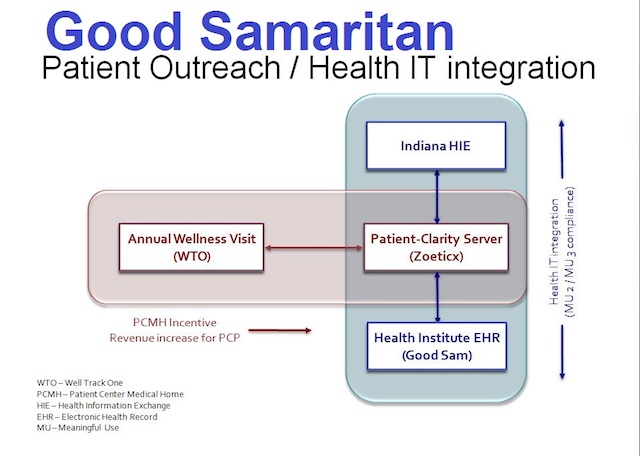WellTrackONE and Zoeticx Demonstrate Interoperability by Integrating Good Samaritan’s EHR System with Indiana HIE
Hospital Anticipates Substantial Revenue Increase While Containing IT integration Costs
 Thanh TranThe long awaited road to true healthcare IT system interoperability is being implemented at Good Samaritan in Indiana, enabling the 232-bed community health-care facility to better deliver on its commitment to delivering exceptional patient care. The system will also enable the hospital to substantially increase their practice’s revenue while containing healthcare system integration costs.
Thanh TranThe long awaited road to true healthcare IT system interoperability is being implemented at Good Samaritan in Indiana, enabling the 232-bed community health-care facility to better deliver on its commitment to delivering exceptional patient care. The system will also enable the hospital to substantially increase their practice’s revenue while containing healthcare system integration costs.
“We strive to be the first choice for healthcare in the communities that we serve and to be the regional center of excellence for health and wellness,” stated Rob McLin, President and CEO of Good Samaritan. “We are proud to be the first hospital in the country to implement this great integrated health record system that will allow us to provide a much higher level of continuity of care for our patients, as they are our top priority."
The integration is being made possible with Zoeticx’s Patient-Clarity interoperability platform which will integrate WellTrackONE’s Annual Wellness Visit (AWV) patient reports with Indiana’s Health Information Exchange (IHIE) and the hospital’s Allscripts EHR. IHIE is the largest HIE in the US, serving 30,000 physicians in 90 hospitals serving six million patients in 17 states.
Revenue Generator for the Hospital
WellTrackONE and Zoeticx will enable patient’s AWV data to flow from the application to Allscripts EHR and the IHIE system. With Zoeticx’s Patient-Clarity platform and WellTrackONE’s software, the healthcare IT integration passes on increased revenue from the Centers of Medicare & Medicaid Services (CMS) and decreased IT costs for medical facilities.
Medicare pays medical facilities $164.84 for each initial patient visit under the AWV program and $116.16 for each additional yearly visit. With the AWV integration in place, the hospital is now able to meet CMS’s stringent requirements for patient reimbursements.
It is estimated that the Good Samaritan will be able to generate $500.00 to $1,200.00 per AWV patient from follow up appointments for additional testing and referrals for approximately 80 percent of the Medicare patients that are flagged by the AWV for testing, imaging and specialty referrals within the hospital.
This subscriber number is expected to trend upwards into 2050 and will create billions in new healthcare revenue through the US as the population ages. The hospital is not charged any costs for the system until it is reimbursed by CMS.
Overcoming Healthcare System Limitations
The hospital began offering Medicare’s AWV’s a few years ago, but had to develop their own tracking protocols which impacted their budget and staff resources. The system they created also operated poorly, allowing them to only view about 10-15 percent of their patient data.
Good Samaritan medical teams were also constrained by interoperability, having to enter new illness findings and other medical info manually and fax PDFs to other facilities where they would have to again be entered into a different system. They also had all of the data contained in WellTrackONE and Allscripts’ system, but no way to integrate the two, let alone achieve that integration with IHIE. Providers were also spending valuable patient face time trying to find specific patient data buried in the EHR system.
“Our systems were working fine, independently of each other,” said Traci French, Director of Business Development and Revenue Integrity. “But we could not achieve true interoperability between the two systems. The best we could do was basically reshuffling PDF documents. The next challenge was to integrate that data with the exchange. We needed to get data to providers where they needed it, when they needed it. “
Searching for a Solution
The facility turned to Robert Storch, Founder, National Medical Reps, who identified three goals when asked to find an interoperability solution for the hospital’s AWV’s integration.
“We wanted to have the ability to seamlessly integrate with any EMR product, but we also saw another specific need that no one in the market had addressed--the inclusion of integration with Health Information Exchanges. It was the best way we could help keep costs down for our customers and allow them to share that information across the HIE’s multiple providers and facilities to provide a better continuity of care to AWV participants,” said Storch.
 “First, I set out to find the best companies we could to integrate the AWV, provide interoperability across all EMRs and include seamless integration into the chronic care management side of the equation,” said Storch. “WellTrackONE was already implemented, but finding Zoeticx was a bit more complicated. Everyone complains about lack of interoperability, but Zoeticx appears to be one of the few companies doing anything about it,” said Storch.
“First, I set out to find the best companies we could to integrate the AWV, provide interoperability across all EMRs and include seamless integration into the chronic care management side of the equation,” said Storch. “WellTrackONE was already implemented, but finding Zoeticx was a bit more complicated. Everyone complains about lack of interoperability, but Zoeticx appears to be one of the few companies doing anything about it,” said Storch.
He discovered that not only did Zoeticx solve interoperability, but it had identified the steps needed to connect the dots of the long elusive CMS stringent requirements for its Chronic Care Management patients.
“It appears that Zoeticx is the first medical facility EHR integrator to access this multi-billion dollar aging population market. This technology breakthrough enables providers to electronically invoice Medicare and Medicaid with a new billing code number, creating a new medical facility profit center and substantially impacting care giver revenue for the approximate 15 million patients who have two chronic diseases and qualify for CCM care,” said Storch.
Connecting 280 Data Points
WellTrackONE gathers and analyzes 280 patient data points, identifying potential catastrophic and chronic medical conditions. Once the assessment is complete, those conditions are outlined for review by a medical provider, flagging potential for current risks and chronic conditions in multiple categories such as functional capacity, safety, cognitive, mental, vision and other areas.
Current and potential catastrophic and chronic conditions that meet CMS’ AWV guidelines are outlined by category, subcategory and severity and include suggestions for clinical testing and referrals to specialists. The clinical triggers provide medically necessary information for follow up visits, lab and other testing as well as referrals of the patient to specialists to ensure the patient is obtaining the best possible care to minimize the risk of hugely expensive catastrophic events.
Addressing All Challenges Associated With the Lack of Interoperability
To begin addressing the integration of these data laden reports and overcoming their previous interoperability, Zoeticx’s Patient-Clarity server used its powerful data switch to “push” WellTrackONES’s reports into both of the hospital’s Allscripts EHRs and the IHIE system. This was done using Zoeticx’s middleware driven Application Program Interface (API) to translate the data. The integration also enables the hospital to enhance its MU2 and MU3 compliance.
The middleware design approach addresses multiple challenges relating to the lack of EHR interoperability. First, WellTrackONE’s solution becomes agnostic to any deployed EHR infrastructure, opening up to more opportunities to address care provider needs for AWV. Second, healthcare IT addresses the challenges of integration where patient medical information flow is now integrated between EHRs and IHIE. The reports are available to all IHIE patients and participating facilities to provide a much higher level of continuity of care for the patient.
Fast implementation was also required from Zoeticx as the hospital was preparing to place an additional Allscripts EHR online. It needed interoperability for the hospital’s two Allscripts EHR systems, one for the clinical side and one for the rest of the hospital, but also its connected facilities.
In addition to speed and seamless integration, the hospital required customization for its billing capability. It had to be able to invoice the AWV under specific physicians while reports from patient assessments were custom routed to the attending physicians via Zoeticx’s platform.
Additional customization was also needed to ensure that the hospital’s laboratories and on-site specialists were included in the referral process by integrating the labs and specialists to the referral links within WellTrackONE. This would enable ease of use and ensuring that the referrals were going to the right lab, testing facility or specialist without manual intervention.
“The whole integration took no time and we were up and running with a newly integrated system. Our expectations were perfectly met and we now have more efficient providers who can better treat patients, their primary goal,” said French. “We also had no out-of-pocket costs and were able to generate substantial revenue for the hospital and its providers and achieve healthcare IT integration between EHR and IHIE at the same time.”
Good Samaritan Proactively Looking Ahead
The next step for Good Samaritan is to add its seamless Chronic Care Management program to the equation. It will provide the hospital with a complete, end-to-end seamless solution that will give providers the latest up-to-date information to manage their patient’s chronic and catastrophic illnesses and provide patients with the best care possible. The challenge would be on supporting the chronic care documents available to care providers within and outside the healthcare network.
Looking toward the future, GHS is also aware of the trend in which hospitals in particular have been purchasing physician and specialty clinics. Physician offices and specialty clinics often have their own EHR systems and they are never upgraded under a single EHR vendor resulting in disparity of EHRs. Similar interoperability problems occur when a hospital system purchases another hospital system or individual hospital, but the complexities are even more pronounced. Different areas of the hospital or clinics within the hospital usually operate a clinic version of the EHR system used by the hospital.
“Whether we need to integrate additional EHRs for our healthcare IT system or through acquisition, with Zoeticx’s interoperability, we are well positioned for any possible future expansion,” French stated.
Thanh Tran is CEO of Zoeticx, Inc., a medical software company located in San Jose, CA. He is a 20 year veteran of Silicon Valley’s IT industry and has held executive positions at many leading software companies.
- Tags:
- Allscripts EHR
- Application Programming Interface (API)
- catastrophic medical conditions
- Centers of Medicare & Medicaid Services (CMS)
- Chronic Care Management program
- chronic medical conditions
- community health-care facility
- continuity of care
- EHR interoperability
- Good Samaritan
- health information exchanges (HIEs)
- Health IT Interoperability
- healthcare IT systems
- Indiana
- Indiana Health Information Exchange (IHIE)
- integrated health record system
- lack of interoperability
- Meaningful Use (MU)
- middleware engine
- MU3 compliance
- National Medical Reps
- patient medical information flow
- patient reimbursements
- patient reports
- Rob McLin
- Robert Storch
- Traci French
- tracking protocols
- WellTrackONE Annual Wellness Visit (AWV)
- Zoeticx
- Zoeticx Patient-Clarity interoperability platform
- Login to post comments